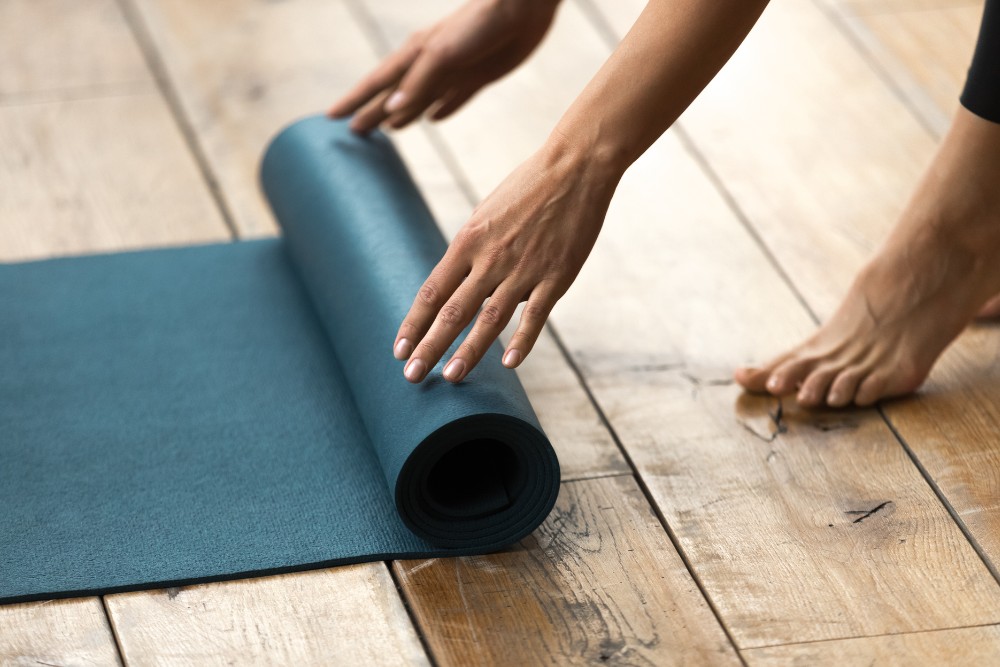BLOG: 5 Reasons You Should Care About the Yoga Mat You Use.
Yoga practitioners often develop a close relationship with their mat.
A yoga mat is often the sole piece of equipment for one’s practice. Who was there with you when you first started out, butterflies in your stomach? Your mat. Who was there when you nailed that challenge asana? Your mat.
You mat is very much your silent partner. Make sure you buy a mat that you want to spend time on and that you can rely on. Consider it an investment. It should do what good partners should do: it should be supportive, not a hindrance.
1. Your Body
In 2009, a New York City team based at Columbia University’s College of Physicians and Surgeons published a list of the most serious yoga-related injuries (defined as ones that were disabling and/or of long duration). The lower back had the highest (231), followed by the shoulder (219), the knee (174) and the neck (110). Then came stroke. The respondents noted four cases in which yoga’s extreme bending and contortions resulted in some degree of brain damage.
The amount of weight and strain our backs are asked to assume can be significant during the course of our practice. Sitting on the floor in and of itself is not as impactful to the body, but during the course of asanas, strain shifts and could be damaging to your back. For example, seated forward folds can put a lot of pressure on the lower back.
Roger Cole, an Iyengar teacher with degrees in psychology from Stanford and the University of California, San Francisco, has written extensively for Yoga Journal and speaks on yoga safety to the American College of Sports Medicine. In one column, Cole discusses modifying shoulder stand poses with accessories like blankets to provide additional cushioning. A thicker mat with adequate grip can also be a great way to protect the shoulders and neck.
According to The Journal of the American Medical Association (JAMA), knee issues can plague even experienced yogis well after class.
A common culprit of pain is the cross-legged position, as flexibility carries from the hips first; if the hips are tight in the pose, the knees will be the first place to feel pain or tension.
It begs the question—why risk it? One of the best ways to look after those injury-prone parts of the body is to ensure you have a mat thick enough to absorb impact and one that provides you enough traction and sweat absorption so that your back, shoulders or knees are neither sliding nor taking on any additional strain than they should be. Extra cushion between you and the floor means less pressure on the bones and joints as you move through poses. A thicker yoga mat ensures that your knees and hips aren’t digging into the floor and causing you pain.
2. Your Hygiene
This issue is mostly addressed by (a) purchasing your own mat and not using mats that the studio provides you and (b) taking the initiative to clean your mat post-practice.
Practitioners are well aware of the amount of sweat endured and the millions of microbes resident in each droplet.
There are many cleansers available on the market, and some studios have home-made solutions which are very effective. You could also consider carrying mat wipes with you; some studios offer these as well. If you happen to forget your mat, and have no choice but to rent or borrow one, put the effort in to clean it before use. While many places clean their mats, what’s the harm in ensuring that yours is clean by doing it yourself?
3. Your Practice
The American College of Sports Medicine recommends a sticky mat, so that feet don’t slide on the mat and so that the mat doesn’t slide on the floor. They also suggest using materials that enable participants to hold their positions and move safely between poses.
I know yoga instructors who will actively pull people off of a mat that they are slipping around on and put them on their own mat (let’s just say hygiene would be secondary to a potential injury).
Mats should not get in the way or be an obstacle to one’s practice. They are intended to aid your practice.
I know of other practitioners who won’t even attempt certain poses because of a lack of trust in their mats. Why keep yourself from the full extent and benefit of an open, expansive practice because of an accessory?
Additionally, a mat that is too thin can fold over easily. If we move our feet to the front of a mat, we may be carrying the back of the mat with us.
While not an issue for hot yoga, mats also add warmth by keeping you from direct contact with a cold wood, tile or concrete floor. And naturally, a thicker mat keeps your muscles warmer. Warm muscles are flexible muscles and less prone to injury.
Thicker mats will also provide more stability. The extra cushioning provided by a thick yoga mat adds to stability as your hands and feet sink into the mat. This allows for a bit of wiggling—the minute adjustments to weight and balance that allow you to stay upright.
I have also heard some practitioners comment that they prefer to feel the floor underneath them in certain asanas, feeling that the stiffer sensation aids their balance. This would endorse a thinner mat.
I believe this issue comes down to personal preference. How do you feel most comfortable? Remember, the mat is intended to support your practice. How you feel may be different than others.
4. Your Wallet
Think about the longevity of your practice. Purchasing a mat should be viewed as an investment, much as you would invest in a car. Do you forego a service or an oil change, only to pay more later fixing a problem? Think about the amount spent on your mat over a three or five-year time frame. If you purchase a mat that lasts, you could get more use out of it.
Ultimately, any kind of injury you sustain would far outweigh (and be far more expensive) the impact of a mat purchase, irrespective of the amount spent or saved on a mat.
Even the most expensive mats are still cheaper than a pair of high end jeans, or the cost of two high end yoga pants or the cost of one to two months of yoga classes (depending on where you practice; donation-based studios being the exception).
Some may call spending high dollar amounts on yoga apparel or accessories as hedonic consumption, but marketing gurus assert that the best way to assuage guilt from this is when there is a high functional value associated with the product.
If yoga didn’t have a high functional value, you’d stop doing it.
5. Your Conscience
Most yoga practitioners extend the caring they provide for themselves through their practice to the caring of the environment. There are many environmentally conscious yoga mat options available; do yourself the favor of buying one. Consumer psychologists agree that the same type of boost we experience from doing yoga can be achieved through the act of giving. Feel good about what you are doing as well as how you take care of yourself—it will enhance your karma. According to the New York Times, in his upcoming book, entitled Give and Take, Wharton Professor Adam Grant talks about how “giving is an opportunity to help people, and therefore it’s an opportunity to feel good about yourself.”
Feel good doing yoga and feel good about yourself by investing in an eco-conscious brand.
Written by Aseem Giri

